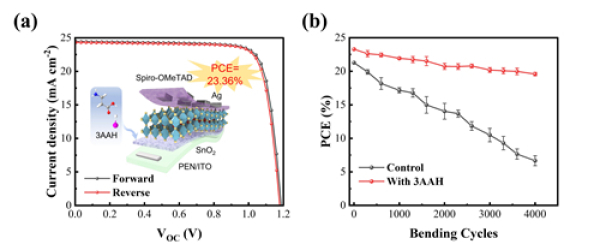The rapid advancement of photovoltaic technology has placed perovskite solar cells (PSCs) at the forefront of scientific interest due to their high efficiency and cost-effectiveness. These cells hold significant promise as a potential successor to traditional crystalline silicon-based solar panels. Among these, flexible perovskite solar cells (f-PSCs) stand out for their potential applications in building-integrated photovoltaics (BIPV), decentralized energy production, and portable electronics charging. Despite their promise, f-PSCs currently lag behind rigid counterparts in terms of photoelectric conversion efficiency (PCE), primarily because achieving uniform and high-quality perovskite films on flexible substrates remains a complex challenge.
A research team led by Dr. Ge Ziyi from the Ningbo Institute of Materials Technology and Engineering, part of the Chinese Academy of Sciences, has made strides in addressing this issue. By employing a bottom-up strategy, they modified the interface between the electron transport layer and the perovskite layer. Specifically, they pre-embedded 3-aminopropionate hydrogenoidate (3AAH) into the electron transport layer. This innovation not only enhanced the quality of the electron transport layer but also facilitated the controlled growth of perovskite grains. The approach successfully alleviated the residual tensile stress induced during the annealing-cooling process, converting it into beneficial microcompressive stress. As a result, the defect density at the perovskite interface was notably reduced, leading to a marked improvement in device performance. The resulting flexible perovskite solar cell achieved an impressive photoelectric conversion efficiency of 23.4%, among the highest ever recorded for flexible perovskite batteries internationally. Additionally, the cell demonstrated exceptional mechanical resilience, maintaining over 84% of its initial PCE after undergoing 4,000 cycles of bending with a radius of 5 mm. This breakthrough offers innovative solutions to bridge the efficiency gap between flexible and rigid devices, propelling the practical application of f-PSCs toward industrial adoption.
This study was published in *Advanced Functional Materials* under the title "Pre-buried ETL with Bottom-Up Strategy Towards Flexible Perovskite Solar Cells with Efficiency Over 23%." It was supported by grants from the National Outstanding Youth Fund and the National Natural Science Foundation.

(a) Schematic illustration and J-V curve of the flexible perovskite solar cell device with pre-embedded 3AAH.
(b) Mechanical bending stability of the flexible device at a curvature radius of 5 mm.
This research not only advances the technological frontier of perovskite solar cells but also underscores the importance of interdisciplinary approaches in addressing critical challenges in renewable energy.
Metal Guard
Accessories Fan Guard,Plastic Fan Guard Filters,Crown Round Fan Guard,Crown 9Cm Fan Guards
Crown Electronics CO., LTD , https://www.crownhaero.com